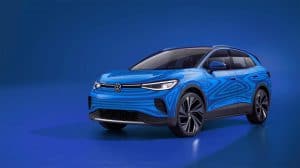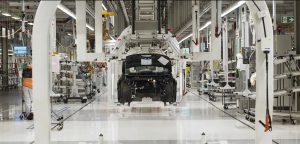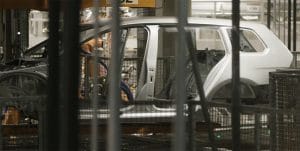The first of the new Volkswagen ID.4 battery-electric vehicles has begun rolling down the Volkswagen assembly line in Zwickau, Germany, the all-electric SUV set to become VW’s first long-range model offered in the U.S. market.
The Zwickau plant recently went through a major renovation that will have it focus exclusively on battery-electric vehicles going forward, and it was already turning out the smaller Volkswagen ID.3 model now on sale in Germany. By mid-decade, the broader Volkswagen Group expects to have around 50 BEVs in production at facilities not only including the Zwickau factory but the expanded assembly line in Chattanooga, Tennessee.
“With the ID.4, Volkswagen is adding an all-electric vehicle to its offering in the compact SUV class, the world’s largest growth segment,” said Ralf Brandstätter, CEO of the Volkswagen brand. “Going forward, the (ID.4) will be built and sold in Europe, in China, and later also in the USA.”
(Leaked images reveal production Volkswagen ID.4 EV.)
Like the ID.3 hatchback, the new battery SUV is based on Volkswagen’s new, all-electric MEB architecture. By sharing that platform with dozens of future models and producing them globally, Brandstätter said, the automaker is “laying the economic foundations for the success of our line-up of long-range electric vehicles.”
The Zwickau plant is one of the automaker’s biggest and underwent a 1.2 billion euro, or $1.4 billion conversion to handle electric vehicle production. While the facility is still in ramp up, VW expects it to be production around 300,000 vehicles next year, at least if the demand is there.
(ID Crozz concept will reach U.S. market as Volkswagen ID.4.)
The ID.4 is expected to be one of the most critical of VW’s battery vehicles, at least initially, because it will help broaden the target audience. The smaller ID.3 hatchback won’t be offered in the States, but the ID.4 will be introduced here by year-end, at least if the rollout goes smoothly.
And “We are right on schedule,” said Thomas Ulbrich, the VW board member overseeing the company’s E-mobility operations.
Even as the first retail-ready versions of the ID.4 start rolling down the line in Zwickau, VW is producing early prototypes of the electric SUV at its plant in Shanghai. The Chattanooga plant, which is undergoing a massive expansion to permit it to build two EV models, won’t launch the ID.4 until 2022.
VW has yet to reveal full details about the ID.4 But visually, a slim chrome bar links twin LED slit headlamps and, one readily notices, there’s no conventional front grille, reflecting the lower need for airflow in an EV, the emphasis shifting to lowered wind resistance. Some air is needed to cool all the electrical and electronic components, and there’s a modest under-bumper, crosshatch grille, as well as twin scoops framing the bumper, likely used for air curtains meant to reduce wind turbulence around the front wheels.

The Zwickau plant went through a $1.4 billion makeover to go all-electric. The VW plant in Chattanooga will also begin producing the ID.4 in 2022.
Beyond the near lack of a grille and the unusually short hood, there is little about the ID.4 that would immediately tell someone that this is a battery-electric vehicle. Audi took a similar approach with its first long-range model, the e-tron SUV, though company officials say they’ll adopt a more distinctive look for future e-tron models.
VW officials have hinted that, with the U.S. version of the ID.4, they are targeting an EPA range of around 250 to 300 miles with the ID.4, numbers that are in line with what potential buyers are saying they now expect. Audi has been faulted for just topping 200 miles with the e-tron and is now offering an expanded-range option.
As for pricing, Volkswagen of America CEO Scott Keogh suggested last autumn in Los Angeles that he’s looking for something in the low to mid-$30,000 range. That’s before a $7,500 federal tax credit. And that could give VW a leg up on Tesla which saw its own federal incentives phase out last year and vanish entirely on Jan. 1, 2020.
(EV sales slumped during first half, even Tesla losing ground despite launch of Model Y.)
The MEB platform will anchor the majority of future BEV models produced by Volkswagen, but it also will be shared with Ford Motor Co. which plans to use it for at least one, and possibly several, of its own future battery-electric vehicles for the European market. It has not been revealed where those Ford versions will be assembled.



